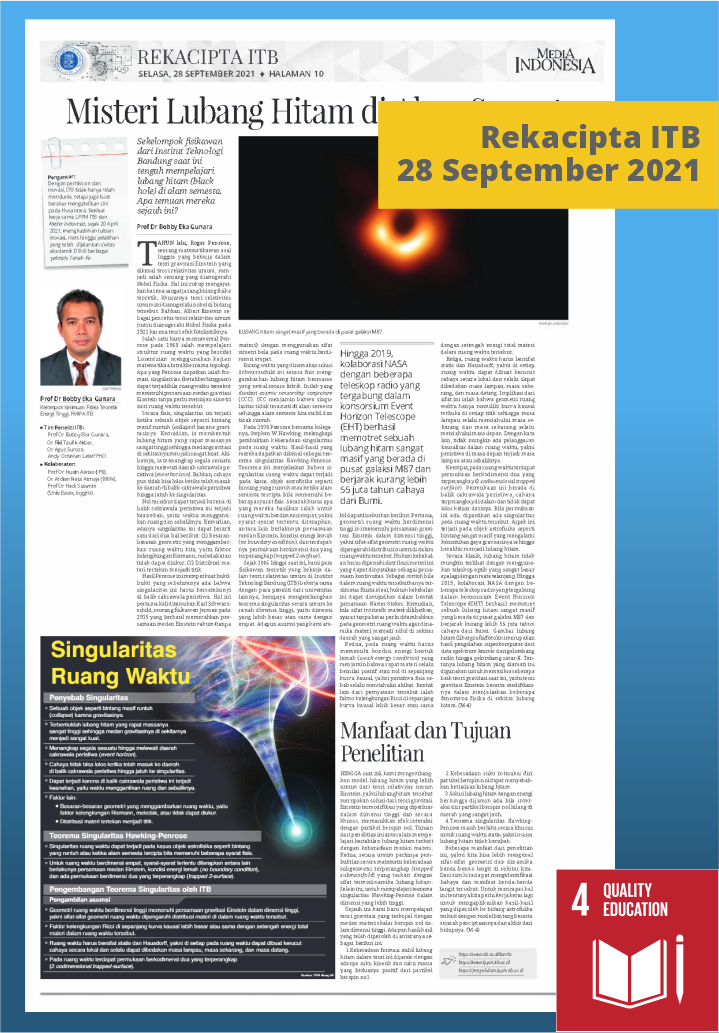Scientific Oration by Prof. Bonar Tua Halomoan Marbun: Integrity of Oil and Geothermal Wells in Indonesia
By M. Naufal Hafizh, S.S.
Editor M. Naufal Hafizh, S.S.
BANDUNG, itb.ac.id – When someone hears the word “well”, one of the images that crosses into the mind is a conventional water well with pulleys and buckets. The same principle also applies in oil and gas wells. This was explained by Prof. Dr. Eng. Bonar Tua Halomoan Marbun during the Scientific Oration of the Professor of the Institut Teknologi Bandung (ITB) in the West Hall of the ITB Ganesha Campus. The title of his scientific oration was “Integrity of Oil, Gas, and Geothermal Wells in Indonesia”.
Prof. Bonar Tua is a distinguished ITB Professor specializing in Oil and Gas Drilling, Production, and Management (TPPM) within ITB’s Faculty of Mining and Petroleum Engineering (FMPE).
He explained that wells have various types based on the shape of their track. There are three types of wells: straight vertical, turning or tilting, and wells with a long track. This is one of the developments in the form of wells that is adapting to the existing oil and gas resources.
The construction of oil and gas wells are quite complex. “Everything has to be carefully prepared to meet certain standards. A well can be special and different from other wells,” said Prof. Bonar.
The well life cycle consists of six phases: basic design, construction design, operations, intervention, and well closure. At the end, the well will be closed after careful consideration of numerous factors, including possible risk and economic potential.
According to the International Standardization Organization (ISO), well integrity is an endeavor to contain and prevent the discharge of fluids, including liquid and gas, into subsurface formations or the ground surface. Meanwhile, according to Norsok, a Norwegian standard which was the first to introduce the concept of well integrity, defines well integrity as the use of technical, operational, and organizational solutions to reduce the risk of uncontrolled formation fluid release throughout the well’s life cycle.
Regarding these standards, Prof. Bonar acknowledged that this input is valuable for Indonesia. “It serves as constructive input for those of us whose standards still require substantial enhancement,” expressed by the alumni of the Technical University of Clausthal.
Well’s integrity requires a multidisciplinary approach involving multiple scientific fields as well as central and regional government entities. Aside from that, it will also involve service providers alongside universities.
The terminology of well integrity is constantly developing, thus a well should be both secure and economically sustainable. This underscores the critical focus of wells since 40% of exploration and exploitation expenditures for oil, gas, and geothermal is a significant number.
Oil and gas exploration strategy in Indonesia often does not align with the actual condition in the field. This is caused by several factors, including inadequate and ineffective equipment. “This evaluation certainly requires attention to enhance strengths and rectify areas that can be improved,” he added.
The integration of oil and gas wells is linked with Carbon Capture Utilization and Storage (CCUS). With the increase of CO2 due to the growing human activities, efforts are being made to absorb and store the CO2 in reservoirs in order to mitigate the effects of global warming.
He concluded his oration by explaining about ITB’s analysis and evaluation of the Batelle study, starting from ITB’s collaboration with the Director of Oil and Gas, Pertamina, and funds provided by the Asian Development Bank under Battelle consultation. “We engage in numerous improvisations, discussion, and positive initiatives to optimize our plans in the context of wells, particularly in Carbon Capture Utilization and Store,” he closed.
You can rewatch Prof. Dr. Eng. Bonar Tua Halomoan Marbun's scientific oration on ITB’s Youtube channel.
Reporter: Kevin Agriva Ginting (Geodesy, 2020)
Translator: Sherina Wijaya (Geological Engineering’ 2019)
Editor: Kezia Hosana

.jpg)
.png)
.jpg)
.jpg)
.jpg)

